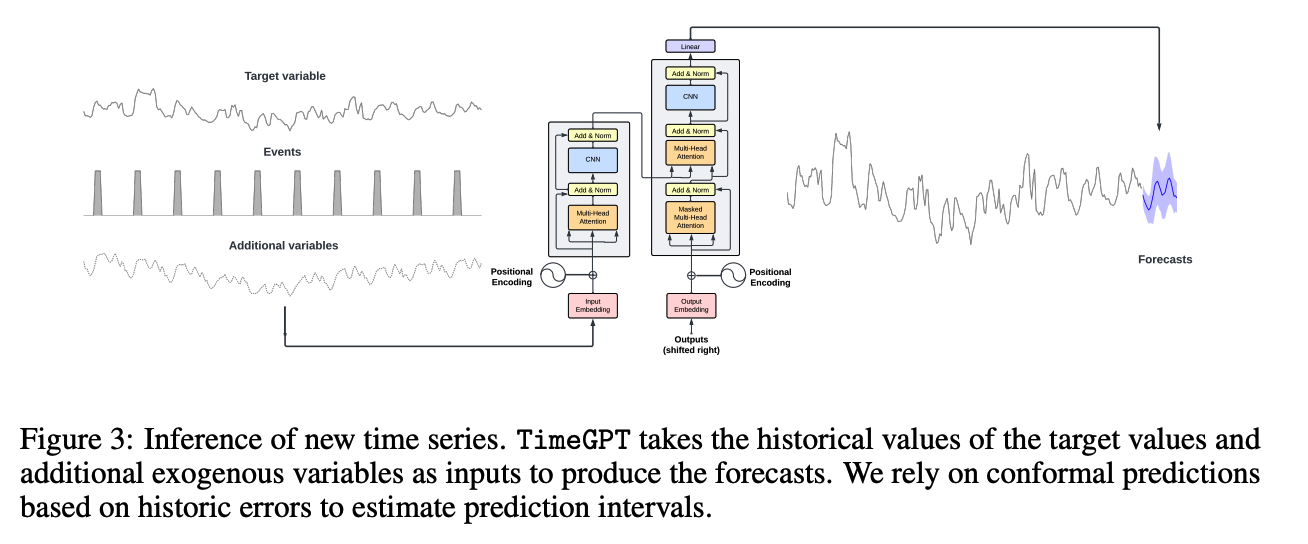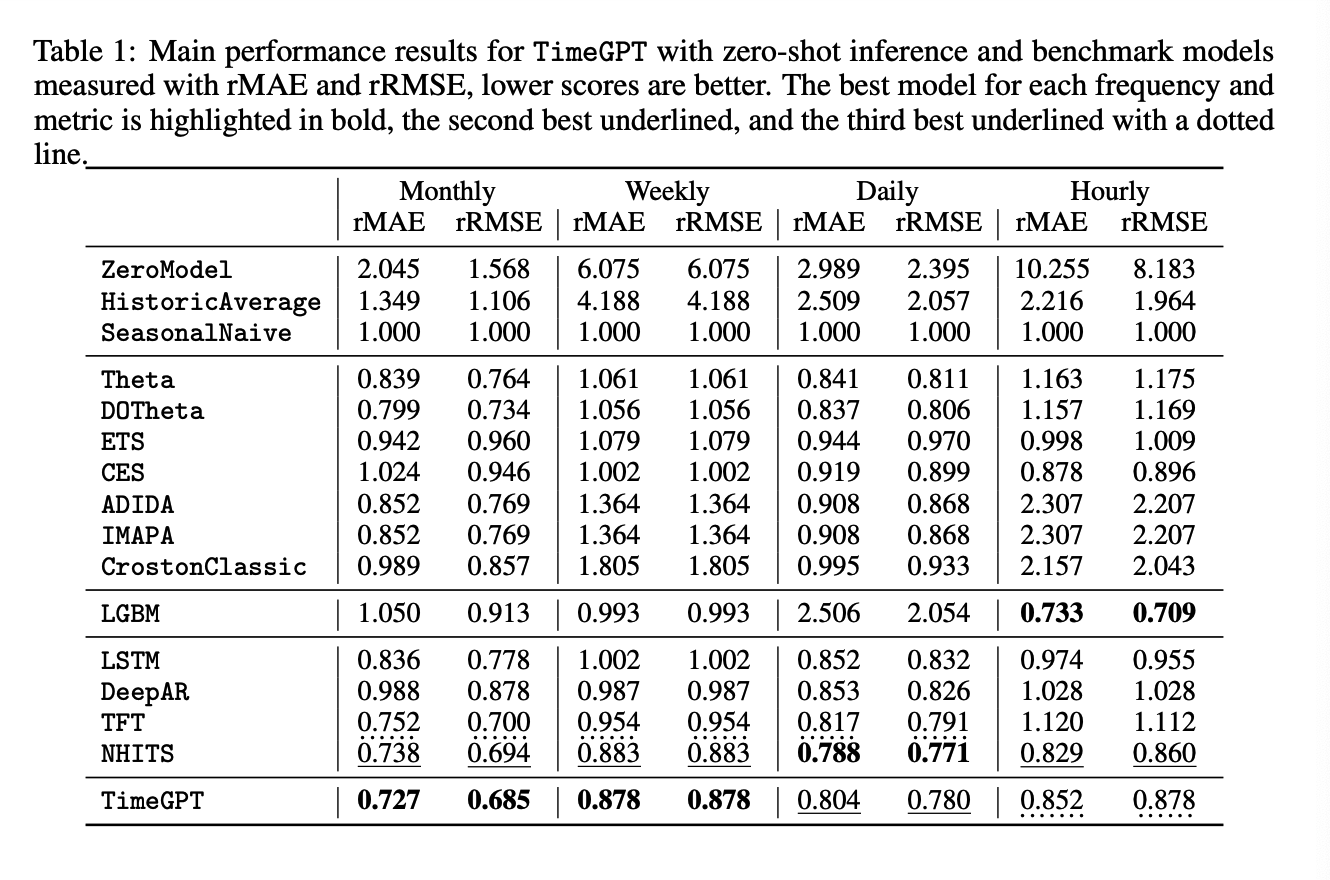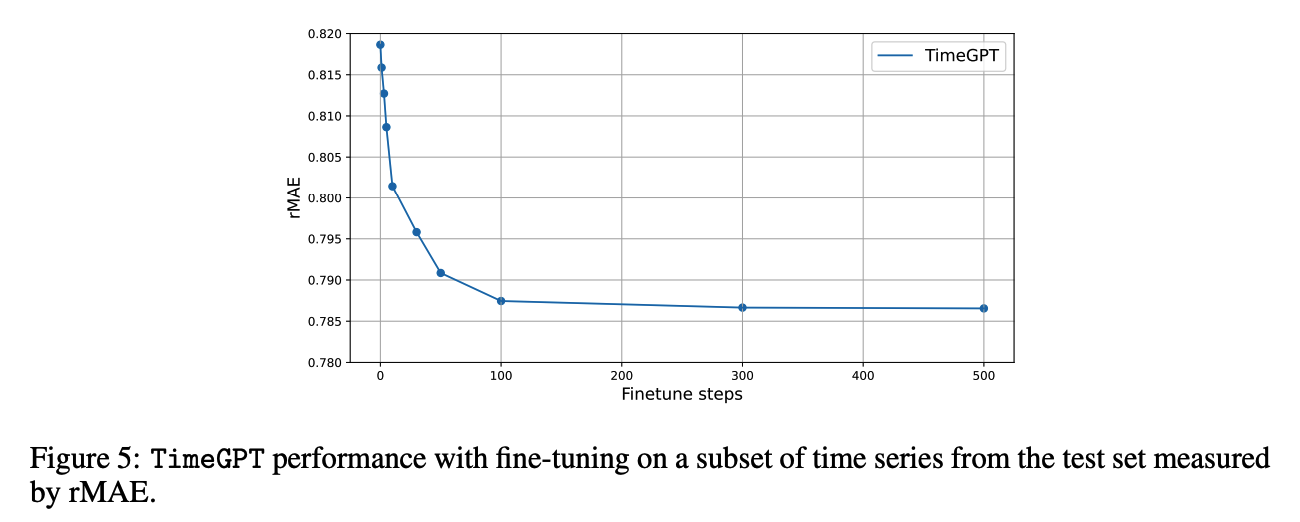TimeGPT-1
Contents
- Abstract
- Background
- Foundation model for TS
- TimeGPT
- Experimental Results
Abstract
TimeGPT
- First foundation model for TS
- Accurate predictions for diverse datasets not seen during training
- TimeGPT zero-shot inference excels in performance, efficiency, and simplicity
1. Background
Superior capabilities of DL models are undeniable for NLP & CV…
However, TS analysis field remains skeptical of the performance of neural forecasting methods.
Why??
- (1) Misaligned or poorly defined evaluation settings
- publicly available datasets for TS do not possess the necessary scale and volume
- (2) Suboptimal models
- given the limited and specific datasets, even well-conceived DL architectures might struggle with generalization
TimeGPT
Larger and more diverse datasets enable more sophisticated models to perform better across various tasks.
\(\rightarrow\) TimeGPT = first foundation model that consistently outperforms alternatives with minimal complexity.
2. Foundation model for TS
Foundation models
-
Rely on their capabilities to generalize across domains
( particularly in new datasets that were not available during training )
Forecasting model: \(f_\theta: \mathcal{X} \mapsto \mathcal{Y}\),
- \(\mathcal{X}=\left\{\mathbf{y}_{[0: t]}, \mathbf{x}_{[0: t+h]}\right\}\) and \(\mathcal{Y}=\left\{\mathbf{y}_{[t+1: t+h]}\right\}\),
- \(h\) : forecast horizon
- \(\mathbf{y}\) : target time series
- \(\mathbf{x}\) : exogenous covariates
Forecasting task objective
-
estimate the following conditional distribution:
\(\mathbb{P}\left(\mathbf{y}_{[t+1: t+h]} \mid \mathbf{y}_{[0: t]}, \mathbf{x}_{[0: t+h]}\right)=f_\theta\left(\mathbf{y}_{[0: t]}, \mathbf{x}_{[0: t+h]}\right)\).
Transfer-learning
- pre-training a model on a large source dataset \(D_s=\) \(\{(\mathbf{X}, \mathbf{y}) \mid \mathbf{X} \in \mathcal{X}, \mathbf{y} \in \mathcal{Y}\}\),
- to improve its performance on a new forecasting task with target dataset \(D_t\).
2 cases of transfer learning
- (1) zero-shot learning
- (2) fine-tuning
The core idea of the presented foundation model is to leverage these principles by training it on the largest publicly available time series dataset
3. TimeGPT
(1) Architecture

TimeGPT
- Transformer-based TS model with self-attention mechanisms
- Procedures
- step 1) Takes a wisdow of historical values to produce the forecast
- step 2) Adding local positional encoding
- step 3) Maps the decoder’s output to the forecasting window dimension
Challenges of TS foundation models
- Primarily due to the complex task of handling signals derived from a broad set of underlying processes
- ex) frequency, sparsity, trend, seasonality, stationarity, and heteroscedasticity …
- Thus, must possess the ability to manage such heterogeneity
TimeGPT
-
Process TS of varied frequencies and characteristics
-
Accommodate different input sizes and forecasting horizons
-
NOT based on an existing large language model (LLM)
( Its architecture is specialized in handling TS data and trained to minimize the forecasting error )
(2) Training Dataset
-
Largest collection of publicly available TS, collectively encompassing over 100 billion data points.
- Broad array of domains
- including finance, economics, demographics, healthcare, weather, IoT sensor data, energy, web traffic, sales, transport, and banking.
-
Multiple number of seasonalities, cycles of different lengths, and various types of trends.
-
Varies in terms of noise and outliers
- Most of the TS were included in their raw form
- limited to format standardization and filling in missing values to ensure data completeness
- Non-stationary real-world data
- trends and patterns can shift over time due to a multitude of factor
(3) Uncertainty quantification
Probabilistic forecasting
-
Estimating a model’s uncertainty around the predictions
-
Conformal prediction (a non-parametric framework)
-
offers a compelling approach to generating prediction intervals with a pre-specified level of coverage accuracy
-
does not require strict distributional assumptions
\(\rightarrow\) making it more flexible and agnostic to the model or TS domain.
-
During the inference of a new TS, we perform rolling forecasts on the latest available data to estimate the model’s errors in forecasting the particular target TS
4. Experimental Results
Forecasting performance evaluation
-
[Classical] Splitting each TS into trian & test, basead on a defined cutoff
\(\rightarrow\) Not strict enough to asses a foundation model, because its main property is the capability to accurately predict completely novel TS
-
[TimeGPT] By testing it in a large and diverse set of TS that were never seen
-
includes over 300 thousand TS from multiple domains
( including finance, web traffic, IoT, weather, demand, and electricity )
-
Details
-
Zero-shot: Without re-training its weights
- Different forecasting horizon : based on the frequency to represent common practical applications
- 12 for monthly, 1 for weekly, 7 for daily, and 24 for hourly data.
- Evaluation metrics
- relative Mean Absolute Error (rMAE)
- relative Root Mean Square Error (rRMSE)
- Normalization at a global scale for each comprehensive dataset
- To ensure both robust numerical stability and consistency in evaluation
\(r M A E=\frac{\sum_{i=1}^n \sum_{t=1}^h \mid y_{i, t}-\hat{y}_{i, t} \mid }{\sum_{i=1}^n \sum_{t=1}^h \mid y_{i, t}-\hat{y}_{i, t}^{\text {base }} \mid }\).
\(r R M S E=\frac{\sum_{i=1}^n \sqrt{\sum_{t=1}^h\left(y_{i, t}-\hat{y}_{i, t}\right)^2}}{\sum_{i=1}^n \sqrt{\sum_{t=1}^h\left(y_{i, t}-\hat{y}_{i, t}^{\text {base }}\right)^2}}\).
Base in rMAE & rMSE?
- Normalized against the performance of the Seasonal Naive model
- Justified by the additional insights offered by these relative errors, as they show performance gains in relation to a known baseline, improving the interpretability of our results
(1) Zero-shot inference

( No additional fine-tuning is performed on the test set )
TimeGPT
- Validity of a forecasting model can only be assessed relative to its performance against competing alternatives.
- Although accuracy is commonly seen as the only relevant metric, computational cost and implementation complexity are key factors for practical applications.
\(\rightarrow\) Results of TimeGPT are the result of a simple and extremely fast invocation of the prediction method of a pre-trained model.
( Other models require a complete pipeline for training and then predicting )
(2) Fine Tuning

(3) Time Comparison
Zero-shot inference
-
average GPU inference speed of 0.6 milliseconds per series
( = nearly mirrors that of the simple Seasonal Naive )
